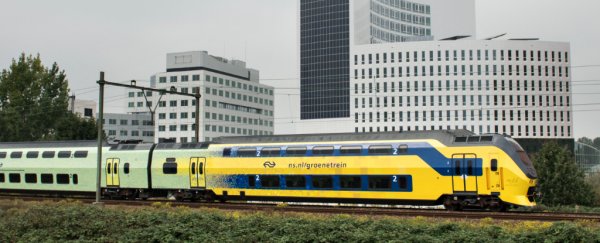The Netherland's national railway company, NS, has announced that all of its electric passenger trains are now 100 percent powered by wind energy.
NS first announced their target for a wind-powered train fleet back in 2015, but they've hit their target a year earlier than planned - way ahead of their 2018 goal.
"Since 1 January, 100 percent of our trains are running on wind energy," said NS spokesman, Ton Boon, in a press release sent to the AFP. "So we in fact reached our goal a year earlier than planned."
In 2015, NS partnered with Dutch electricity company Eneco. Their goal was getting NS's entire electric train fleet wind-powered by January 2018.
Half of the fleet was already wind-powered, but in order to get the entire system away from fossil fuels, they needed to either build more local wind farms or buy in wind energy from neighbouring countries, such as Denmark.
But thanks to an increase in the number of wind farms around the country, and off the coast of the Netherlands, the collaboration has achieved that target early.
According to a joint NS and Eneco website, around 600,000 passengers every day are now travelling thanks to wind energy.
The Dutch have a long history with wind energy, and have been using windmills to drain water and mill grain since the 17th and 18th centuries. But now the nation is using more sophisticated wind turbines to generate electricity.
According to Eneco and NS, one windmill running for an hour can power a train for around 200 km (120 miles).
And although trains are usually thought of as pretty environmentally friendly compared to fuel-heavy cars, the NS fleet annually consumes 1.2 billion kWh of wind energy from Eneco - equivalent to the amount of electricity consumed by all households in Amsterdam in a year.
"Mobility is responsible for 20 percent of CO2 emissions in the Netherlands, and if we want to keep travelling, it is important that we do this without burdening the environment with CO2 and particulate matter," Eneco account manager Michel Kerkhof told Railway Technology back in 2015.
"This contract offers all Dutch citizens the option to make a climate neutral trip, regardless of distance."
The collaboration now hopes to reduce the energy used per passenger by a further 35 percent by 2020 compared to 2005.
And if global trends are anything to go by, it shouldn't be that hard. Just last year, Costa Rica was able to go 250 days without burning any fossil fuels, largely thanks to its hydro, geothermal, and wind energy.
Scotland was also able to generate more wind electricity than the entire country could use on a particularly windy day in 2016. And Denmark got 42 percent of its national electricity from wind power in 2015, despite having two of its biggest wind farms offline.
So, the planet might still be heating up, but we've finally passed the point where renewable energy has more power generation capacity than fossil fuels for the first time.
And thanks to countries like the Netherlands, there's no turning back now.
